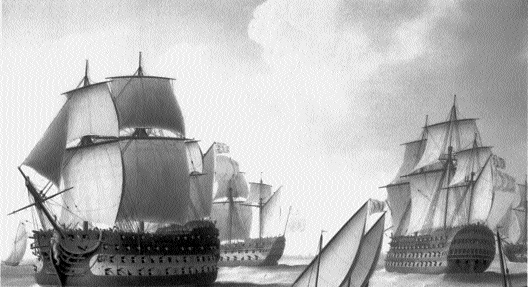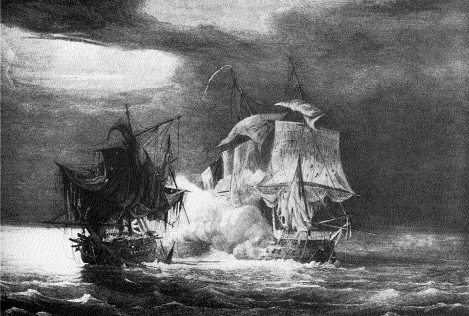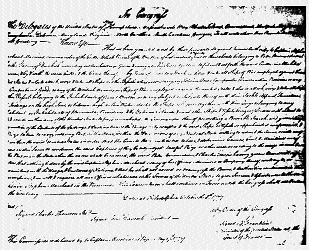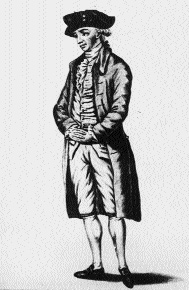An Irish Buccaneer
Published in Early Modern History (1500–1700), Features, Issue 2 (Summer 1999), Volume 7
On the right, British first-rate 80-gun three-deck ship-of-the-line, similar to the Berwick which took Luke Ryan’s Calonne in 1781. (Leningrad Municipal Art Gallery)
Near St Abbe’s Head, south of the Firth of Forth, a heavily armed French privateer Calonne flying French colours had just captured the merchant brig Nancy from Aberdeen bound for Newcastle. The Calonne, also known as the La Cologne, was a 400 ton ex-French naval frigate, two-decked and armed with thirty-six cannon with a crew of nearly 250 men of Irish, French, American and Dutch nationalities. The small unarmed brig the Nancy was a valuable prize. The captain of the Calonne was a Luke Ryan from Rush, County Dublin. Ryan had decided to ransom the brig by bargaining with its captain, John Ramsay. They finally settled on a figure of 300 guineas. The ransom papers were signed and the Nancy cut loose. Ramsay stayed on board the French privateer as hostage to secure payment of the ransom notes. The lookout hollered ‘sail-o’ as a number of sails appeared on the horizon as dusk started to fall on that evening of 16 April 1781. Ramsay, the canny Scot, told Ryan that they were Greenlandmen whaling ships on their way to the Arctic. Ryan swallowed the bait and the Calonne set off in hot pursuit. Ryan fired two broadsides at his quarry and then ordered a heave-to and sent over a boarding party. In the poor light of evening Ryan realised that his intended prizes were not easy Arctic whalers but two British fully armed men-of-war. The Berwick was a large first-rate seventy-four-gun man-of-war that outgunned and out-manned the Calonne. What was worse was that her escort, the thirty-six-gun double-decked Belle Poule, initially out of sight, had come around fast from behind the Calonne firing broadsides. The exchange of broadsides between the Calonne and the Belle Poule lasted an hour. Then the Berwick arrived and Ryan surrendered. Boarding parties captured the Calonne crew and Ryan was initially treated as a French officer by Captain Patton of the Berwick. The Calonne was taken in tow by the Berwick to Edinburgh. Ryan was transferred to Edinburgh Castle and was formally charged with high treason and to await extradition under Scottish law to London. Other Irish crew members were also interned but the remainder, mostly French and Americans were exchanged. On 10 October, both Ryan and his Irish first mate Thomas Coppinger were brought by road under heavy armed escort to London, charged before Judge Marriot at the Admiralty Sessions Court at the Old Bailey with high treason and the piratical taking of vessels, including the brig Nancy three leagues from St Abbe’s Head off the Scottish coast.
Background
At his trial in March 1782, Luke Ryan insisted on speaking French, gave his name as ‘Luc Ryan’ and claimed that he was a naturalised citizen of Louis XVI. However, his fluency in French broke down and the official report wryly commented that he spoke English for a Rush man ‘tolerably well’.
Prosecution evidence presented at the court centred on affidavits from the Rush community in north County Dublin. The local landlord Robert Echlin was the proprietor of the Kenure estate during the 1750s but had relinquished his interest in the estate to the Palmer family of Mayo. Echlin’s affidavit stated Luke Ryan was the only son of Michael and Mary Ryan of Kenure and the parish register was produced to show that a Luke Ryan was born on the 14 February 1750 in Rush. Other witnesses from Rush, including Ryan’s first cousins the Griffin brothers, John Farren and Michael Bishop, all testified under oath that they knew him as a child in Rush and Skerries.

A nineteenth-century print of a French privateer attacking a British merchantman. (Gilbert Collection, Art Resource, N.Y.)
In 1760, Luke was employed as a stable hand in the Hamiltons’ Hackettstown estate near Skerries and in 1762 was apprenticed to John Grimes, shipwright of Skerries. Further evidence was heard that in 1766 Luke was indentured to Edward King as a ship’s carpenter at his boatyard in Ringsend.
Letters of marque and reprisal
The ‘law of nations’ was a medieval set of rules and understandings that originated during the Crusades for delineation of maritime obligations and responsibilities between one nation and nationals of another in peace and war. The instrument of authority was known as a ‘letter of marque’, or ‘letter of reprisal’ to remedy a private wrong when an individual could take action against a foreign sovereign state by seizing properties, particularly vessels owned by that state to the value of the debt. From the end of the seventeenth century to the middle of the nineteenth, the letter of marque as a remedy for a private personal wrong was no longer in use. It had now become a formal instrument of state. Governments could augment their national navies, during time of war, by issuing letters of marque to the owners and masters of vessels to convert them at their own expense to ‘private man-of-wars’ or ‘privateers’. A ‘prize’ was a vessel captured by the privateer and its authority was its letter of marque.
The origin of privateering was based in international medieval treaties that determined the prerogatives of belligerent maritime nations to set up ‘admiralty prize courts’ specifically constituted for the duration of hostilities. These courts determined whether a captured vessel was a legitimate prize and assessed in cash terms the amounts shared out between the privateer’s officers and crew after levies and expenses. Privateers of all nations used subterfuge to gain the confidence of their prize. However, there were a number of basic regulations that enjoined the destruction of the prize and embezzlement of the cargoes and secured the humane treatment of the master and crews. A privateer captain must bring the master (the ransomer) and at least one officer and all the ship’s documents to the prize court in order to claim his prize. It was a serious offence for a privateer to take a ship of a friendly or neutral nation. Using a privateer for smuggling or seizing allied shipping was an infringement of the letter of marque and a capital offence.
Dunkirk
The port of Dunkirk was the centre of European smuggling activities and during the American War of Independence became the privateering and prize court centre of Europe. The French civil service administered privateering at Dunkirk as a thriving local industry by charging rewards, fines and duties levied on behalf of Louis XVI. Dunkirk had layers of middlemen—armateurs—agents who supplied money to arm, outfit and commission the privateers; the French government supplied the port facilities for the conversion and refurbishment of smuggling vessels and redundant naval ships for privateering. Dunkirk attracted adventurers of all nations who were eager to share in the risk and rewards of privateering.
Scottish and Irish ports were affected by the American Revolution: raids by commissioned American officers Lambert Wickes (1777) and John Paul Jones (1778 and 1779) badly upset Irish shipping and trade. The English Admiralty began to offer privateering commissions to owners of Irish vessels as a response. Early in 1778, the Dublin, a converted ‘fast’ smuggler armed with sixteen four-pounders captained by John Harding from Loughshinny and manned by a crew of 150 men mostly from north Fingal and with an English letter of marque, sailed from Dublin as an Irish privateer. Luke Ryan and Edward Wilde of Loughshinny had become partners in a large smuggling vessel, the Friendship with fourteen swivel guns and a crew of sixty Rush men. In February 1778 the Friendship was fitted out at Sir John Rogerston’s Quay and converted from smuggler to privateer.
The voyages of Luke Ryan
The Friendship sailed from Dublin in February 1779 and returned by the end of May. It now appears that the Friendship was bought by the Dunkirk armateur Jean Torris, and both Ryan and Wilde (sometimes known as McCatter) were minority owners. Torris was in the unusual position of owning a privateer that still carried an English admiralty letter of marque.
The Friendship had returned to Ireland with contraband goods probably bought from Torris. The Irish revenue defined both Ryan and his first cousin Wilde of Rush as piratical smugglers. John Draper, Superintendent of Excise for Dublin Port, arrested the Friendship at Rogerstown with Wilde and some crew members and impounded the goods. Later, Wilde and some other members of the Friendship crew broke out of Black Dog Prison at Ringsend and boarded armed wherries which had arrived from Skerries. They took the Friendship, the revenue guard cut the anchor line, and they sailed back to Rush. Here, they collected Ryan and more men and sailed south-easterly to Dunkirk after leaving the revenue men on shore in Dorset.

Benjamin Franklin’s 1779 commission to Stephen Marchant of the Black Prince. In reality Ryan was the captain but the American Congress could only issue commissions to citizens of the United States.
On arrival in Dunkirk, Jean Torris renamed the Friendship the Black Prince with Ryan in command and Edward Wilde (alias McCatter) and Patrick Dowling as his officers. Later Benjamin Franklin through Torris had commissioned the Black Prince as an American privateer with an American letter of marque. The only stipulation was that an American merchant seaman Stephen Marchant from Boston would be listed as captain to fulfil the legal requirements.
In June 1779, Ryan sailed the Black Prince from Dunkirk with a full complement and returned to Morlaix with eight British prizes in tow. During July the Black Prince ransomed a further thirteen British coasters. On the third cruise to the Scillies the Black Prince captured eight prizes (including a Waterford brig, the Sally-Anne) and brought in eighteen ransomers to Morlaix. In September, the Black Prince sailed along the west coast of Britain as far as the Hebrides and returned to France with thirty-four prizes. Marchant resigned and returned to the United States after this voyage.
A new privateer, the Black Princess, was outfitted by Torris and Edward Wilde (McCatter) and received an American commission. Meanwhile, Patrick Dowling received the American commission for the Black Prince. In January 1780, Torris and Ryan wrote to Franklin requesting another vessel with an American commission for Ryan’s captaincy. Franklin responded and purchased a new privateer, the Fearnot, originally a French man-of-war, the Sans Peur, with Ryan as master. She was refurbished, sailed in 1780 for the Orkneys and seized sixteen prizes on this tour. The presence of Ryan and the Fearnot caused mayhem in Scottish ports:
letters from Scotland mention that the Fearnought (sic) privateer, Luke Ryan commander, landed at Stornaway, in the island of Lewis, and after plundering the town, carried off the principal inhabitants hostages, as ransomers for the houses.
(Freemans Journal, 28 July 1780)
However, by the summer of 1780, the activities of Irish privateers with American commissions had become a source of political irritation for the French government and a major worry to Benjamin Franklin and the American Congress. Pressure was brought to bear on reluctant Franklin to revoke American commissions to non-American nationals in his service. This was not known to Ryan who had been given command of the three-decked, thirty-two-gun frigate Calonne that was sold to Torris by the French navy and had a complement of 250 men. Before his capture in the Firth of Forth Ryan had seized thirteen prizes and had considered himself safe from British prosecution as he had acquired French citizenship, and held both an American commission and an American letter of marque. Little did he know that the commission had been withdrawn by Franklin.
Ryan had successfully captured 114 prizes from mid-1779—sailing in five different privateers: Black Prince (Friendship), Black Princess, Fearnot, La Marechal and Calonne—to his capture by the Berwick in 1781. He had ransomed a total of seventy-six masters of British vessels and exchanged 161 merchant seamen during his short and lucrative career. In just over two years, Luke Ryan and his friends Wilde (McCatter), and Dowling from Rush commanded under American and French commissions, sailed under flags of three different nations and on opposite sides in the same war. According to statistics quoted in a British House of Lords debate in February 1778, American privateers had captured or destroyed 733 British and Irish prizes with cargoes valued in excess of £2 million. In 1783 the House was told that privateers during the American war had cost the British merchant navy more than an estimated £8 million in damages.
‘Mayhem, murder & mutiny’: the trial of Luke Ryan
Ryan and Coppinger were charged with the multiple crimes of mayhem, murder, mutiny, treason and piracy against George III and were lodged in New Gaol, Southwark. On the 31 October 1781 they appeared before the infamous Admiralty justice Sir James Marriott at the High Court of the Admiralty in the Old Bailey and were formally charged by a Grand Jury for piracy and treason. Ryan’s defence never disputed that he had committed acts of privateering flying French and American colours preying on British shipping in time of war.
Ryan’s attorney, John Peckham, objected strongly to the new double charge stating that they had agreed during the plea-bargaining that the charge of piracy would be dropped and treason maintained. Ryan was joined in Newgate Prison by Edward Wilde (Black Princess) who had been captured off the Scillies. The Royal Navy had been successful in capturing all of Luke Ryan’s squadron including James Sweetman and Mathew Knight from Rush who were tried and convicted during the summer of 1782.
The trial of Luke Ryan took place at the Justice Hall of the Old Bailey on the 30 March 1782. Judge Marriot and the Attorney General Sir William Scott prosecuted. The main argument concerned Ryan’s country of birth. If he was French-born he was not subject to English law and would go free while if he was an Irish-born subject of George III then he was guilty of piracy and he would hang at Wapping. Defence witnesses from France swore that Ryan was the son of Lieutenant Joseph Ryan in Dillon’s French Brigade at Dunkirk and a register was produced showing that Ryan was born in the village of Gravelin in northern France. It was further explained that on his father’s death in France Ryan had been brought to Ireland as an infant and reared by his uncle, a tenant farmer on the Echlin estate at Kenure during the 1750s near the hamlet of Rush in the county of Dublin.
Most of the French evidence was dismissed by Marriot. The state maintained that Luke Ryan was born in Rush on the 14 February 1750 and was able to produce documentary evidence as well as Ryan’s relations from Rush who supported the state’s case. The trial lasted three weeks and the jury found Ryan guilty of piracy and treason as charged. Thomas Coppinger turned state witness and was acquitted. Edward Wilde (McCatter), Nicholas Field of Skerries, Edward Duffy of Baldungan were all convicted of piracy and treason. On the 14 May 1782, the defendants Ryan, Wilde, Field, Duffy and Thomas Farrell (the first officer aboard the Princess) were sentenced to be ‘caged’ on the 23 June 1782 at Wapping. The execution of pirates in eighteenth-century London involved first partial strangulation and then transfer in chains to heavy man-size cages suspended above the Thames. At high tide the cages were lowered into the river and the condemned men died by drowning. This was known as ‘wapping’ in cockney slang.

Captain Luke Ryan (Hibernian Magazine, May 1782)
Ryan and the others were confined to Newgate to await appeal. Ryan’s wife and five children left Rush and settled in one of the Hampshire ports, probably close to Portsmouth. In May 1782, a member of the Ryan squadron and fellow Rush man Patrick Dowling in the French Fearnot privateer and a large party of men landed at Skerries and burnt houses including that of Frederick Connygham the revenue agent. This was in retaliation for the conviction of Ryan on the evidence given by Connygham and his part in the arrest of the old Friendship at Rogerstown.
Pardon
Pressure mounted on the Rockingham ministry to pardon Ryan as a gesture of goodwill in the peace negotiations with the American and French governments and appeals flowed into the English Admiralty. Lord Shelbourne, the Home Secretary, following recommendations from cabinet suggested that Ryan should be pardoned but one of the pirates should be executed ‘for the example to others’. The Lords of the Admiralty granted a respite but sentenced Daniel Casey, Sweetman’s first mate, to death by caging.
Hostilities with the United States Congress and the Kingdom of France ceased on 27 February 1783 and Ryan and the other four prisoners were granted a ‘royal and free pardon’. Ironically, Ryan did not go free as he had accumulated huge debts for his defence during the trial and continued to languish at Newgate. The French government liquidated some of Torris’s assets and the proceeds were sent to London to clear Ryan’s legal debts. He was released on the 9 February 1784.
Aftermath
Ryan settled in Hampshire and took legal action against Torris, the French government and his bank at Roscoff for moneys (over £70,000) which he maintained was owed to him. He was declared bankrupt in 1788. He was arrested on the 25 February 1789 by the High Sheriff of Hampshire for his failure to pay £200 owed to doctors who had inoculated him and his family in the ‘Jenner’ method against smallpox. He died in the King’s Prison on the 18 June 1789 of septicaemia.
Eugene Coyle is a local historian and writer.
Further reading:
J. Shiels, ‘Captain Luke Ryan of Rush’, Dublin Historical Record (1971).
G. Rutherford, ‘The King against Luke Ryan’, Mariner’s Mirror (London 1957).
E.A. Coyle, ‘Luke Ryan—Privateer’, Skerries Historical Society (1998).
D.A. Petrie, ‘The Piracy Trial of Luke Ryan’, The American Neptune, vol.55, no.3 (Salem 1995)
















